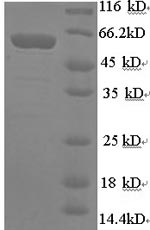The region for expressing recombinant Human SYN1 contains amino acids 113-420. This SYN1 protein is expected to have a theoretical molecular weight of 61.6 kDa. This SYN1 protein is produced using e.coli expression system. The SYN1 coding gene included the N-terminal GST tag, which simplifies the detection and purification processes of the recombinant SYN1 protein in following stages of expression and purification.
Synapsin-1 (SYN1) is a neuronal phosphoprotein that plays a crucial role in regulating neurotransmitter release and synaptic vesicle trafficking. It belongs to the synapsin family, which consists of three isoforms (I, II, and III) and is primarily associated with the presynaptic terminals of neurons. SYN1 is involved in the modulation of synaptic transmission by tethering synaptic vesicles to the cytoskeleton and regulating their availability for release. Phosphorylation of SYN1 by various protein kinases, including cAMP-dependent protein kinase (PKA) and calcium/calmodulin-dependent protein kinase II (CaMKII), is a key regulatory mechanism controlling its activity. Research on SYN1 encompasses investigations into synaptic plasticity, neurotransmitter release, and the molecular mechanisms underlying neurological and psychiatric disorders, as alterations in SYN1 function have been implicated in conditions such as epilepsy, schizophrenia, and bipolar disorder.




